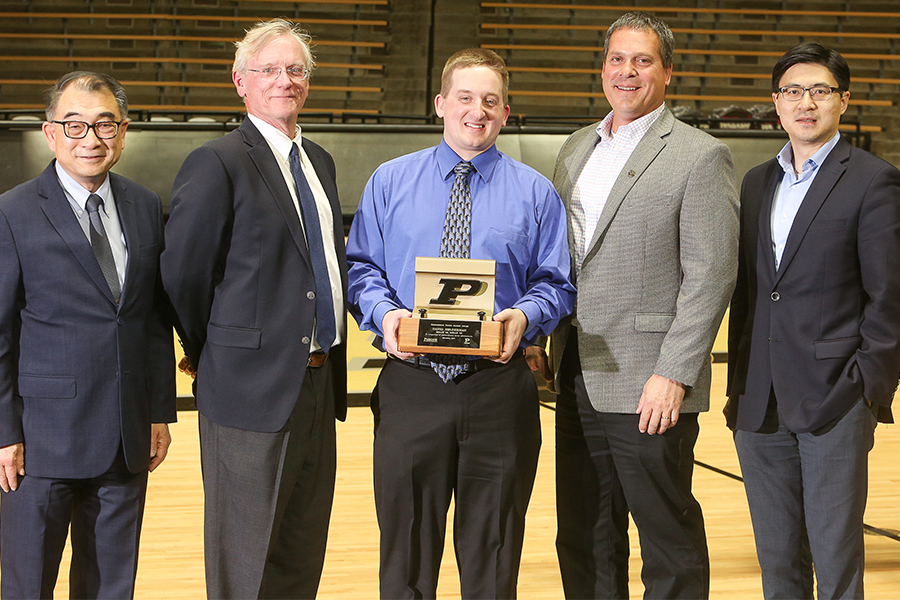Steps at Zucrow helped propel Helderman to commercial space industry
David Helderman couldn’t quite believe his fortune.
More than 15 years after producing crayon drawings of spaceships, he was getting daily overloaded, in the best possible way, with the unique opportunities Purdue’s Maurice J. Zucrow Laboratories presented.
For a three-year span during Helderman’s undergraduate and graduate years at Purdue, he was embedded in every aspect of testing from how to design a facility, how to design rocket combustors, how to select the components, how to do the wiring, the software, and data reduction. If it had to be done, Helderman did it.
“There was nothing I didn’t have to do,” he says. “That was an amazing opportunity to learn every single aspect of that job, of how to do that and how to do testing properly, how to get it set up. Hands down, the best experience, the best three years of hands-on learning that I’ve had ever.”
And served as a perfect segue into his current gig, as a pivotal cog in helping advance the commercial space industry.
“Without a doubt, it’s the thing that got me my job at Blue Origin,” he says.
Helderman’s college destination was a no-brainer for multiple reasons. Both parents are alumni, so he has “Boilermaker blood,” and he knew from an early age he wanted to be an aerospace engineer — and Purdue’s School of Aeronautics and Astronautics is a top-ranked program in the country. But it was when he first got the chance to work at Zucrow that he started to really envision what his career could be.
An AAE535 Design, Build, Test course taught by AAE Professor Bill Anderson had Helderman working on a hydrogen-oxygen torch igniter. Much of the early research was done in the class, but Helderman continued the research as an independent study class the following semester. The igniter was successfully developed, and Helderman says Purdue has been using it for a decade now to light most of its rocket combustors.
“When I started out at Zucrow Labs, I really knew nothing about rocket engine testing, other than coursework,” Helderman says. “It really helped me be very successful, that dedicated three years of hard work.
“That’s really what set off my whole career.”
And it’s been quite a career already.
Helderman (BSAAE ’06, MSAAE ’09) joined Blue Origin as a test engineer after graduating from Purdue. He ran the BE-3 test engine test program on the facility side, getting the test facility set up, and ran testing of the BE-3 engine, development, qualification, and, eventually, acceptance of that engine before it started flying on the New Shepard program.

Now, he’s the director for test and launch engineering, the group that is responsible for the design and development of all the launch pads and test stands at Blue Origin across the country. Blue Origin has facilities in Washington and Texas and also is building a launch facility for New Glenn, an orbital launch vehicle, in Florida.
For his achievements, Helderman received Purdue’s College of Engineering 2017 Young Alumnus Award, presented to a graduate who has demonstrated a rapid advancement in their chosen field.
But he’s eager to keep forging ahead, taking steps to help the industry pursue the next giant leap in space exploration.
“We always tell people that if this isn’t your passion, if you’re not excited about this, there are a lot of easier places to work. It’s very hard work, but it’s very rewarding, it’s very fun, especially if you’re excited about space,” he says. “There is exciting stuff going on every day.
“The commercial space industry over the next 10 years is going to be awesome. Blue Origin and many of the other companies are all doing new and exciting things.”
More from 150th series: Tamaira Ross
The Purdue sesquicentennial
The Purdue University Sesquicentennial Campaign, 150 Years of Giant Leaps, is a yearlong celebration of Purdue, its remarkable people, its unique history and its visionary drive to meet the world’s future challenges. From Homecoming 2018 through Homecoming 2019, the Purdue community will spend the year celebrating its unique legacy, which has included giant leaps across every field of endeavor, and further advancing the mission set forth since its founding as a land-grant university in 1869. With the campaign serving as a springboard for a renewed commitment to growth, innovation and discovery, Purdue’s call is simple: Whatever your pursuit, take Giant Leaps.

